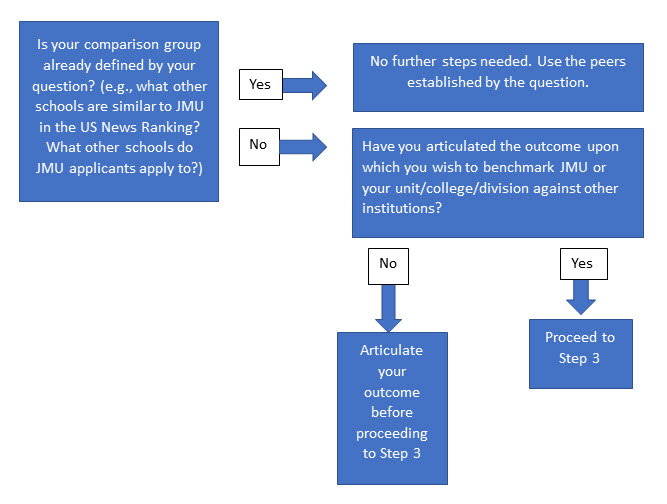Articulate the purpose of your peer group
If you determine that a pre-existing peer group—like those with the same Carnegie Classification—won’t suffice, then the first step is to articulate the purpose of the group you’re trying to develop.
Action Item: Provide a response to the following prompt:
We are developing a peer group for the purpose of determining ___________.
Some common examples might include:
- Benchmarking JMU against institutions to compare the relative standing of average salaries. If we are in the lower half of the peer group, it might require us to consider ways to increase salaries to become more competitive in hiring and retention efforts.
- Comparing JMU against other institutions in terms of graduation rates. How does JMU compare against institutions with similar characteristics on this important student outcome? If we do well, why is that? If we do poorly, what are the factors?
- Benchmarking a specific college at JMU against similar ones at other institutions to compare the number of tenured faculty in that area. This information might be useful for a dean to make a case to the provost for additional faculty lines.
This step should be completed before all others and should serve to articulate the purpose of establishing the peer group.
Use the flowchart below to help you determine the best way to proceed:

Aspirants vs. Peers
We often want to compare ourselves against aspirant institutions. As the name suggests, these are institutions we aspire to become more like. To determine aspirant institutions, however, we must first determine institutions that we are similar to in some way so that we can then identify the way in which we want to be more like them.
As an example, we may aspire to resemble a set of institutions in terms of research expenditures. To do this, we must first determine the ways in which these aspirant schools are comparable to us. In the example of research expenditures, are there types of institutions that we would not aspire to be like for research? How about institutions with medical schools? Do we aspire to have the research expenditures of a flagship R1? Choosing aspirant institutions means first choosing the outcome we aspire to improve, then identifying institutions, divisions, colleges, or programs that are comparable to us in other ways but outpace us on the outcome of interest (e.g., research expenditures).
This process can still be used to establish an aspirant list. Here, your purpose is to identify the outcome on which we aspire to improve, then follow the rest of the steps to establish a set of institutions with levels of that outcome above ours.
